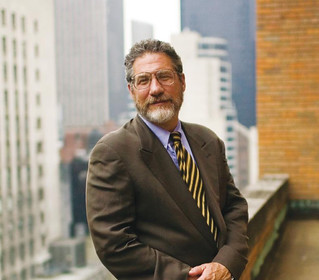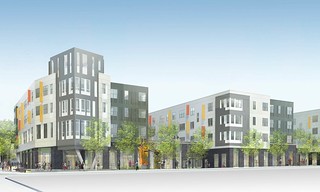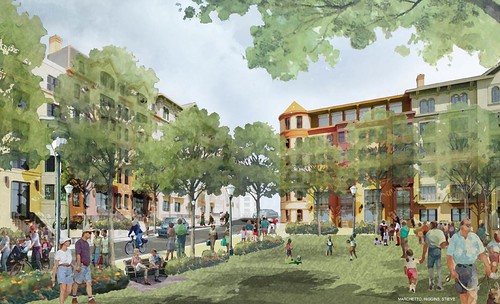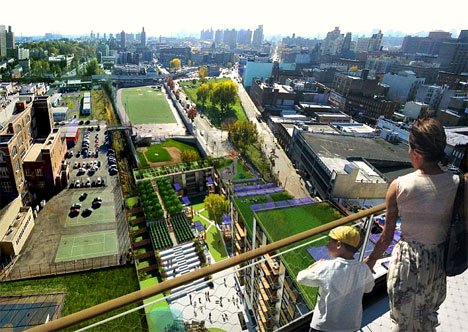Honoring a sustainability champion who 'repairs the fabric of communities'

Posted November 9, 2012 at 1:27PM
Last year I had the honor of introducing the prominent green developer Jonathan F. P. Rose, and I put it this way: “I may be an advocate for sustainability, but Jonathan is a builder of sustainability.” He is a doer, not only a man of ideas and words but also someone who, as they say, Gets Things Done. Earlier this week Rose was awarded the James W. Rouse Civic Medal of Honor by Enterprise Community Partners in New York City. As I was able to tell him in a brief conversation at the large, gala event, the honor is very well-earned.
Today’s article is going to be factual, but I cannot claim that it will be unbiased. Jonathan is a supporter and trustee of the organization I work for, NRDC, and someone I often look to for advice and perspective on all sorts of things having to do with green development and sustainable practices. I have learned a lot from Jonathan and his firm, the Jonathan Rose Companies, where my good friend and fellow traveler Daniel Hernandez is managing director for planning. They especially keep me honest on the pragmatic side, delineating what can and cannot realistically be accomplished in the complicated world of real estate financing and building. I love the firm’s work and am pleased to count Jonathan among my professional friends.
 Jonathan’s introduction to NRDC was not exactly a smooth one: we sued him. He and his frequent collaborator, the visionary architect Peter Calthorpe, had proposed a comprehensive development scheme for the Atlantic Terminal section of Brooklyn, a large and transit-rich former rail facility that was ripe for smart development and next to the massive Atlantic Yards site now being developed by Forest City Ratner. I don’t know why NRDC challenged the plan, exactly; ours is a large, multi-city organization and I wasn’t consulted. But I have seen elements of that long-since-abandoned scheme and, to my eyes, it looks a lot better than what is actually being built in that vicinity now.
Jonathan’s introduction to NRDC was not exactly a smooth one: we sued him. He and his frequent collaborator, the visionary architect Peter Calthorpe, had proposed a comprehensive development scheme for the Atlantic Terminal section of Brooklyn, a large and transit-rich former rail facility that was ripe for smart development and next to the massive Atlantic Yards site now being developed by Forest City Ratner. I don’t know why NRDC challenged the plan, exactly; ours is a large, multi-city organization and I wasn’t consulted. But I have seen elements of that long-since-abandoned scheme and, to my eyes, it looks a lot better than what is actually being built in that vicinity now.
This was before we were as active in these issues as we are now. I’m sure there were some legitimate environmental concerns with the proposal – there’s no such thing as zero-impact development. But one of the things we know now that we didn’t know then is that we would be highly unlikely to find a for-profit developer more understanding of and committed to sustainable practices than Jonathan Rose. He is a great environmental advocate, a great champion of placemaking for underserved populations, and a committed and discerning philanthropist. It’s kind of a long story, but Jonathan is now also a great asset to our organization.
At Enterprise’s 30th anniversary gala where Jonathan was honored, federal Housing and Urban Development Secretary (and former New York City housing commissioner) Shaun Donovan spoke. He called Via Verde, the spectacular affordable and ultra-green housing project in the South Bronx, the most exciting project he had seen in the city while serving as housing commissioner. Via Verde was one of Jonathan’s projects, and it was his vision, along with the sensitivity and skill of his design and development partners, that made it happen.
I don’t know if it would be accurate to say that Jonathan invented the concept of green affordable housing – bringing the many benefits of sustainability to distressed neighborhoods and populations – but I am quite sure he has been the concept’s most visible, consistent and effective champion. About a decade ago, Jonathan and Enterprise’s then-president (and heck of a nice guy) Barton Harvey came to NRDC and asked us to help them create a set of environmental standards to support a five-year, $555 million commitment to build 8,500 affordable, healthy and energy-efficient homes. We knew right away that this was a big deal, and we were honored to lend our support to that effort, which in 2004 officially became known as the highly influential Enterprise Green Communities program (we helped name it, as I recall).
Enterprise, a major sponsor of affordable housing nationwide, reached their goals for that initiative a year ahead of schedule, and the organization continues today to follow the green criteria in most of their investment portfolio. Moreover, many other supporters of affordable housing have followed suit in one way or another and the Green Communities criteria are even written into law in some jurisdictions that now provide special benefits to qualifying projects. It would not have happened without Jonathan.
Having come from a family of real estate developers, Jonathan started his company about 20 years ago with one employee. By 2010, when he was interviewed by Vivian Marino for The New York Times, the operation had expanded to 70 people, managing a portfolio of work worth $1.5 billion. The firm’s mission is “to repair the fabric of communities”:
“Jonathan Rose Companies [pursues] transformative change by creating green urban solutions as replicable models of environmentally, socially and economically responsible plans, communities, buildings and investments.
“Our mission is to repair and strengthen the fabric of cities, towns and villages, while preserving the land around them. To do this, we have organized our work around four areas of practice to conceive, plan, develop and finance green urban solutions. The result is equitable, and supports the social, economic, environmental, cultural and educational health of the regions in which we live and work.”
That, coincidentally, is also pretty much my own job description.
Although at this point I know the firm’s portfolio well enough that I’m usually aware of its involvement, I used to run a cross a great project that I wanted to tell everyone about – the amazing Atlanta Beltline, for example, or Denver’s now-iconic exemplar of smart growth, Highlands’ Garden Village – only to then discover that the Rose Companies were involved. When Jutka Terris, Nancy Vorsanger and I wrote our book Solving Sprawl (Island Press, 2001), two of the 35 smart growth stories we profiled – Irvington, New York’s Burnham Building (adaptive reuse of a transit-adjacent historic property as a green library with affordable homes) and Santa Fe’s Second Street Studios (affordable live/work units) – were Jonathan’s.
Here are just a few more of the many, many great projects that Jonathan Rose Companies is involved with:
- Newark’s new master plan: the firm was selected by the city of Newark, New Jersey to prepare a master plan to define and guide the city’s policies, budgets and priorities through 2025. The plan, which involves an extensive civic engagement process,
 will be centered on a vision of leveraging and driving regional economic growth, creating healthy and safe neighborhoods, and building a sustainable city.
will be centered on a vision of leveraging and driving regional economic growth, creating healthy and safe neighborhoods, and building a sustainable city. - Paseo Verde, Philadelphia: the firm is developing a two-acre parcel of land adjacent to the fourth busiest stop in Philly’s regional transit system, serving Temple University. The development will be a sustainable, mixed-use rental housing project for 120 low- and moderate-income families, and it will have energy-efficient design, a green roof with landscaped terraces (similar in concept to those at Via Verde), solar panels, use of local, recyclable, and renewable materials, and onsite health services. (In 2011 NRDC participated in a sustainability charrette for the project keyed to LEED for Neighborhood Development, as we did more recently for Boston’s Codman Square.)
- Aria, Denver: a multi-generational, mixed-income and mixed-use community with adaptive reuse of historic buildings and an exceptionally diverse array of housing choices, Aria occupies the site of a former convent. The development, which will be affordable to working families, is innovative in that it saves costs by relying extensively on modular green construction, with major portions of new buildings manufactured off-site according to replicable templates, and then assembled on the project's grounds. The project includes a network of gardens, pocket parks and pathways, combined with community programming in its public spaces. The Sisters of St. Francis continue to live on the site, but now in the new Aria homes.
- Metro Green, Stamford, Connecticut: Certified LEED-ND gold and compliant with Enterprise’s Green Communities standards, Metro Green when complete will include 238 mixed-income residences on a mixed-use site located one block from the Metro North Stamford Railroad Station. The first phase, a 50-unit apartment building, includes a new public plaza featuring a rain-garden streetscape, a high-performance building envelope, energy-efficient mechanical systems, and recycled and locally sourced building materials.
- A $75 million affordable housing partnership with Citigroup, focusing on redeveloping and building new properties in New Jersey, Connecticut, and Washington, DC.
I could go on and on and on. The firm’s body of completed and ongoing work is large and seriously impressive.
I could also tell you about the Garrison Institute, which strives to tap “inner sources of compassion, motivation, innovation, insight and vision” through contemplative practice, in part to support “professional caregivers, human service providers, educators, environmental advocates, and others whose work involves building a healthier, smarter, more resilient future.” The Institute was founded by Jonathan’s wife Diana, Jonathan, and several like-minded souls and leaders. I certainly recall the time Jonathan missed an important NRDC meeting because, well, he was with the Dalai Lama.
Enterprise's big party earlier this week opened with ethereal live music that seemed to my ears to be some sort of blend of African guitar, a flute, and something that sounded sort of like a steel drum. I didn’t get a close look. I was pretty sure that wasn’t by accident and, sure enough, Jonathan told me he had picked the band. I thought they were great. Given everything that has happened recently in New York and in lower Manhattan, where the event was held, it seemed a more appropriate choice than something more rocking.
But despite some real hardships in the city because of the hurricane, there was a big crowd, turning out to support Enterprise and to support Jonathan. I’m glad I was among them. As I said earlier, it was well-earned.
Related posts:
- Bank of America supports affordable green neighborhoods with grant program (June 1, 2012)
- The spectacular 'green way' to build affordable housing (October 13, 2011)
- Distressed city neighborhoods need green investment for community, environment (March 19, 2010)
- Great short video on greening smart growth with living nature (August 17, 2009, featuring a video with Jonathan Rose)
- New report: how city parks can support affordable housing (May 28, 2009)
Move your cursor over the images for credit information.



